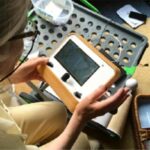Mementoes act as emotional companions that anchor stories. Older adults typically have a rich knowledge of family mementoes. However, storytelling and preservation of mementoes are still problematic for them: their mementoes are still mostly in physical format, which is difficult to share and preserve. Additionally, digital applications and websites for sharing mementoes usually are inaccessible for them. As a result, they spend much time collecting mementoes, but spend less time on telling and recording the related stories. In response to this, we report our study driven by the research questions: Rq1: What are the characteristics of older adults’ intergenerational memento storytelling? And Rq2: In which ways could a tangible display facilitate intergenerational memento storytelling for older adults? We designed a tangible device named Slots-Memento. We first conducted a preliminary evaluation to refine the prototype. In the field study, eight pairs of participants (each pair consisting of an older adult and his/her child) were recruited to use the prototype for around 1 week. Semi-structured interviews were then conducted both with the older adults and their children. Subsequently, mementoes collected were categorized and analyzed. Stories collected were firstly transcribed, then were conducted with structural and interactional analysis. In the concluding discussion, we present abstract implications for the research questions: two tables summarizing characteristics of their intergenerational memento storytelling, and related strategies of designing a tangible display individually.
Supporting intergenerational memento storytelling for older adults through a tangible display: a case study
C. Li, J. Hu, B. Hengeveld, and C. Hummels, “Supporting intergenerational memento storytelling for older adults through a tangible display: a case study,” Personal and Ubiquitous Computing, pp. 1-25, 2020.
DOI: 10.1007/s00779-020-01364-9
